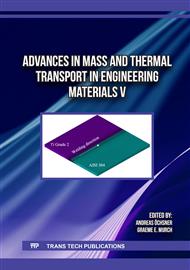[1]
H. Bruus, Theoretical microfluidics, Lecture notes, Third edition, vol. 6 (2004).
Google Scholar
[2]
B. Heidt et al., The Liberalization of Microfluidics: Form 2 Benchtop 3D Printing as an Affordable Alternative to Established Manufacturing Methods, Phys. Status Solidi A, 217.
DOI: 10.1002/pssa.201900935
Google Scholar
[3]
S. B. Berry, J. J. Lee, J. Berthier, E. Berthier, and A. B. Theberge, Droplet incubation and splitting in open microfluidic channels, Analytical Methods, 11 (2019) 4528–4536.
DOI: 10.1039/c9ay00758j
Google Scholar
[4]
M. J. Beauchamp, A. V. Nielsen, H. Gong, G. P. Nordin, and A. T. Woolley, 3D Printed Microfluidic Devices for Microchip Electrophoresis of Preterm Birth Biomarkers, Anal Chem, 91 (2019) 7418–7425.
DOI: 10.1021/acs.analchem.9b01395
Google Scholar
[5]
O. A. Al-wdan, O. A. Sharallah, N. A. Abdelwahab, A. O. Mohammed, E. Elmowafy, and M. E. Soliman, Insights into microfabrication and implementation of microfluidics in pharmaceutical drug delivery and analysis, OpenNano, 12 (2023) 100156.
DOI: 10.1016/j.onano.2023.100156
Google Scholar
[6]
M. Bucco, La impresión 3D y su aplicación en los servicios médicos (prótesis, fármacos, órganos), 2016.
Google Scholar
[7]
A. Hawke, G. Concilia, P. Thurgood, A. Ahnood, S. Baratchi, and K. Khoshmanesh, A 3D printed flow sensor for microfluidic applications, Sens Actuators A Phys, 362 (2023).
DOI: 10.1016/j.sna.2023.114686
Google Scholar
[8]
E. A. Galan, H. Zhao, X. Wang, Q. Dai, W. T. S. Huck, and S. Ma, Intelligent Microfluidics: The Convergence of Machine Learning and Microfluidics in Materials Science and Biomedicine," Matter, Cell Press, 3 (2020) 1893–1922.
DOI: 10.1016/j.matt.2020.08.034
Google Scholar
[9]
B. Evans, Practical 3D printers: The Science and Art of 3D Printing, Apress, 2012.
Google Scholar
[10]
A. Ortiz, Las impresoras 3D como herramientas científicas, Dialnet, 21(2019).
Google Scholar
[11]
J. Prusa, ¿Qué es la impresión 3D?, The Future of Manufacturing. 2023. [Online]. Available: https://afs.prusa3d.com/es/info/que-es-la-impresion-3d
Google Scholar
[12]
R. Valverde, IMPRESORAS 3D: Marco teórico, modelos de desarrollo y campos de aplicación Nuevas prácticas culturales y artísticas Tesis realizada por Roxana Valverde Ponce.
Google Scholar
[13]
Craftcloud, Tipos de impresoras 3D: las 7 tecnologías de impresión 3D., ALL3DP. 2023. [Online]. Available: https://all3dp.com/es/1/tipos-de-impresoras-3d-tecnologia-de-impresion-3d/
DOI: 10.2307/jj.5076228.4
Google Scholar
[14]
Microfluídica: Descripción General, Malvern Panalytical. 2023. [Online]. Available: https://www.malvernpanalytical.com/es/products/technology/microfluidics
Google Scholar
[15]
E. A. Galan, H. Zhao, X. Wang, Q. Dai, W. T. S. Huck, and S. Ma, Intelligent Microfluidics: The Convergence of Machine Learning and Microfluidics in Materials Science and Biomedicine, Matter, 3 (2020) 1893–1922.
DOI: 10.1016/j.matt.2020.08.034
Google Scholar
[16]
C. Cárdenas, Microfluídica: el arte de fluir en espacios diminutos, Stamm. 2023. [Online]. Available: https://www.stamm.bio/es/microfluidica-el-arte-de-fluir-en-espacios-diminutos/
DOI: 10.4995/thesis/10251/61767
Google Scholar
[17]
Guía de microfluídica, milifluídica y fabricación de laboratorio en un chip, formlabs. 2023. [Online]. Available: https://formlabs.com/latam/blog/microfluidica-milifluidica-fabricacion-laboratorio-chip/
Google Scholar
[18]
K. Oh, K. Lee, B. Ahn, and E. Furlani, Design of pressure-driven microfluidic networks using electric circuit analogy, Lab Chip, 12 (2012) 515–545.
DOI: 10.1039/c2lc20799k
Google Scholar
[19]
Un dispositivo microfluídico puede revolucionar los diagnósticos, SaluDigital. 2023. [Online]. Available: https://www.consalud.es/saludigital/tecnologia-sanitaria/un-dispositivo-microfluidico-puede-revolucionar-los-diagnosticos_54081_102.html
Google Scholar
[20]
P. Juárez Jiménez and D. T. De, DISPOSITIVO MICROFLÍDICO MODULAR. LAB-ON-A-CHIP, UPM (2018).
Google Scholar
[21]
J. David, J. Díaz, H. Alonso, and C. Bañol, Numero de Reynolds, 2015.
Google Scholar
[22]
J. Bernal, Manufactura Aditiva: Innovación y Eficiencia en la Fabricación 3D, Tecnología del Plástico. 2023. [Online]. Available: https://www.plastico.com/es/noticias/manufactura-aditiva-como-proceso-productivo-una-realidad
Google Scholar
[23]
F. Rupp et al., A review on the wettability of dental implant surfaces I: Theoretical and experimental aspects, Acta Biomaterialia, 10 (2014) 2894–2906.
DOI: 10.1016/j.actbio.2014.02.040
Google Scholar


